#wall hung toilet in Mumbai
Text
"Wall Hung Toilets: Browse Top Selections in Mumbai - Salus India"
premium wall hung toilets in Mumbai at Salus India. Explore our range for sleek designs and quality craftsmanship. Shop now
0 notes
Link
With a growth of 15 to 17% in demand for sanitary goods per year, Sanitary Fittings in India have strengthened their dealer network by offering showroom incentives to international brands and by opening their retail outlets in major cities. For more visit us at https://visual.ly/community/Infographics/home/sanitary-fittings-india
#Channel Drainers in india#Wooden Wash Basins in Mumbai#Wall-Hung Toilets#Wash Basin in India#Pressure Pump For Bathroom
0 notes
Text
We Two Dervishes: Istanbul Diaries
If you do not wish to read the whole article but are interested in a typical itinerary and tips, skip to the last section. Important tips are highlighted in Bold also.
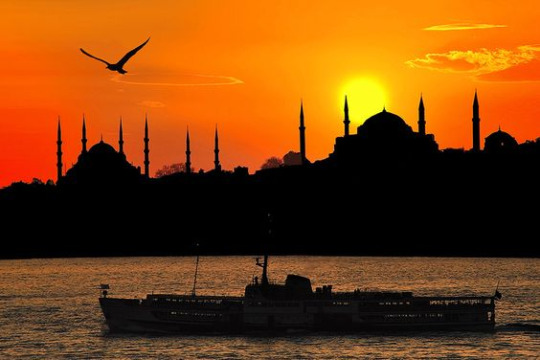
Courtesy: Mehmet Gören (Pintrest)
Pins and Needles
To think that this trip almost never happened.
ProTip: Take the visa rules very seriously. The spirit doesn’t matter, the letter absolutely does. Also, never overestimate Consulates and Visa centres, if they say it will take 10 days, take it to mean that it will take 11 days at least and prepare accordingly.
4 days until the trip, no visa in hand, sleepless nights, continuously refreshing the VFS website for any change in the status of arrival of Visa from Mumbai to Ahmedabad, estimating time it takes for courier services to deliver a package from Mumbai to Ahmedabad and constantly flitting between self reassurance and sick-in-the-stomach worry that visa won’t arrive on time. If only we had been a day early, the situation where a small delay could fully derail the trip I have wanted to take for a long time would not have precipitated, and all the preparation, from ordering The Museum of Innocence, to vividly imagining/dreaming of being there would sink in front of our eyes. To say nothing of the monetary loss, because we had booked non-refundable flights.
The visa arrived two and a half hours before our departure to Mumbai. The VFS staff weren’t sure when the damn thing would come, so we just decided to camp out in front of the visa centre and wait for the Blue Dart mini-truck. Fortunately they were expecting a delivery in the evening, and they were kind enough to give our visas to us after their working hours (Visa Centres and Consulates are strict about their working hours. Fervently so). I am not sure when the last time I had a tsunami of relief wash over was. The package soon arrived and we heard the guard talking amongst themselves about arrival of Japanese, American, and to our good fortune, Turkish. We ran to Forex centre close by, requesting them on phone to stay open for a little while (thankfully, they wanted our business) and managed to buy a modest sum of 230 Euros, because that’s all the Euros they had.
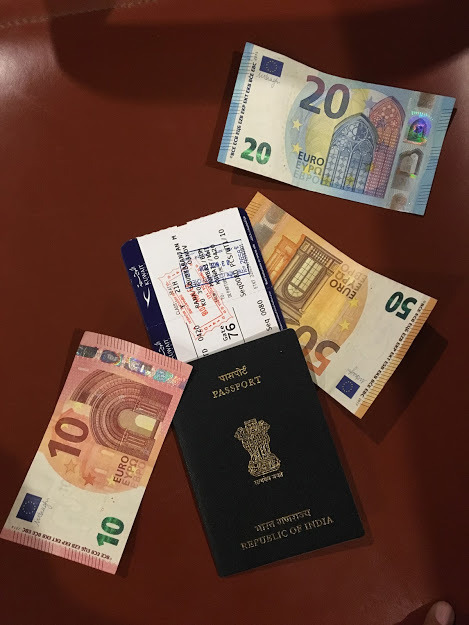
Sigh of Relief
Battlefield
I would like to argue that the first country out of my own that I have stepped on is Turkey and that layovers don’t count, because boy Kuwait City was disappointing. The only fascinating thing that one can see in the darkness before dawn break are the fires in the oil fields. Kuwait City, especially the area around the airport looks like an empty abandoned desert, and it should because it is far from the actual Kuwait City. If you look at the map of Kuwait, you will be struck by the featurelessness of the country, apart from the dense network of roads around a small tip that is Kuwait City. The airliner from Mumbai had nice food (as airplane foods go), and a courteous and diverse staff: You had an Indian, an Arabian, a Caucasian, an African, and an Asian. The Cinema and TV selection were average, but the movies were heavily censored. Even words like ‘Hell’ were muted, and absolutely no scenes of intimacy, even those that would be demure by Bollywood standards!
The airport has 2 terminals. The old one receives flights from Mumbai, and the new modern terminal services to Istanbul. The ground staff, or the lack of them is particularly pain in the ass. It was 6a.m and passengers were to be transferred to new terminal, and the staff was scrambling to get the security officer and the bus driver to service the passengers, causing delays. This worried me a bit during the onward flight, because the return flight, we had a layover of meagre 1 hour 25 min. (And my fears came true. The return flight departed half an hour late from Istanbul, because of a fuel leakage which stalled our take-off and put us right at the end of the queue. We had to scramble to get to put flight to Mumbai, because guess what, it rained that day. In a desert.) The Security check was especially very adamant on checking each and every item in the baggage. In fact, they didn’t even allow us the toothpaste, so we had to go foul mouthed all the way till our hotel at Istanbul!
The ground staff of the airport comprised mostly of, you guessed it, immigrants. And of those, most of them are South Asians. And of those, most of them appeared Malayalis, fulfilling the Gulf dream as their counterparts elsewhere. You can easily get by with Hindi around the airport at least. And the toilets do not have urinals! This complies with the personal law prescribed in Islam. The washrooms at Istanbul do have the urinals though.
KWI of course was a battlefield in the Battle of Kuwait International Airport, a significant battle of the Gulf War between US and allies and occupying Iraq led by Saddam Hussein.

Where Airlift was Set
Why Istanbul?
Because Istanbul is magical. A place where the streets whisper to you the tales the glory and doom, rise and fall; ascension and declination of emperors, sultans and revolutionaries; not unlike the undulating terrain it occupies. The place where the East meets West, the great continents and civilisations of Asia and Europe face off across a narrow waterbody that also connects North with the South. To see Istanbul, to understand Istanbul is to understand the history of the culture and civilisation of a major part of the world, in fact the world itself. Devout muslims, avid history buffs, Europhiles, party creatures- they will all find in the ruins and the glory of the city what they are looking for.
Istanbul is a time capsule, a place where time is laid out in space like a spread out deck of cards.
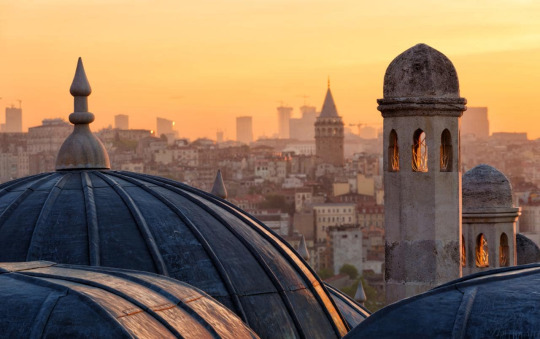
A stock photo
It’s a Church! It’s a Mosque! It’s Museum!
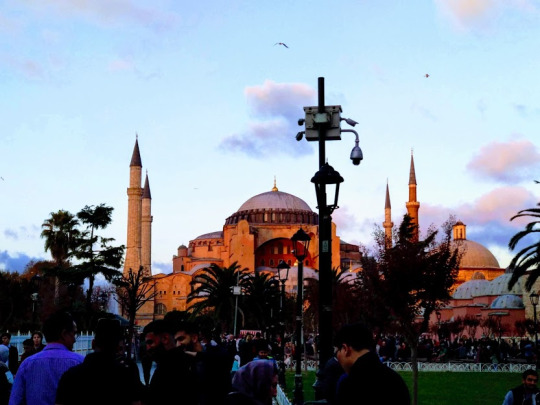
My fascination with Ayasofya or Hagia Sophia, or the magnitude of it, is somewhat a puzzle to me. I do not know why I have been entranced by this beautiful, beautiful Eastern Roman/Ottoman marvel. I know for certain it began when I first read about it in Netfundu magazine in my school days. Netfundu was a kiddie magazine complimentary during the heydays of Indian Airlines, the domestic govt. operated carrier before it was disastrously merged with Air India. Maybe it was about the name or it was about the architecture, but it never escaped my imagination after that. It is an important must see for travellers visiting Istanbul, and is one of those things that do not disappoint, despite a small part of it being covered with scaffolding for renovation.
Where else will you see Jesus, Mary, Allah and Muhammad together in one single place?
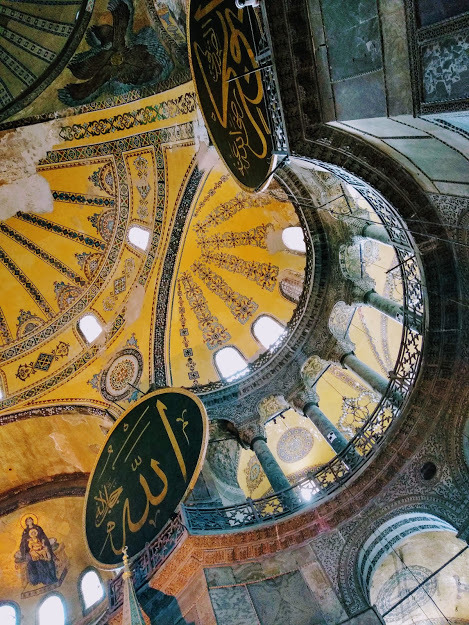
After capturing Constantinople, the Ottomans removed or plastered over mosaics and images of Jesus, Mary, Constantine, Justinian and various other Byzantine Emperors from the walls, as Islam prohibits representation of human figures because no one but Allah is allowed to create. This is the reason why Topkapı, Blue Mosque and all the other Ottoman palaces (Not Dolmabahçe; we will come to that) are covered with exquisite tiles and carpets as decoration and not paintings, as a guide we shamelessly eavesdropped at Blue Mosque tried to explain his captive (and paying) group. Orhan Pamuk’s masterpiece My Name Is Red, the book that put in me the fascination to visit Istanbul, devotes a considerable portion of his book discussing this aspect of Islamic philosophy, of prohibition of creating realistic portraits, thereby challenging Allah. This attitude is reflected even now, with reports of Modern day Saudi Arabia destroying historical artifacts around Mecca to build hotels. Or ISIS destroying Palmyra. Sultan Mehmed II, the conqueror (Fatih, which now renders its name to the UNESCO heritage historic area of the old city. Note similarity to the Hindustani word ‘Fateh’) ordered a massacre of Roman residents, then asked for muslim immigrants to settle Constantinople, and converted Hagia Sophia, the ‘Church of Wisdom’, into a mosque.
The images that we see of Jesus, Mary and the other kings were restored by Swiss-Italians Fossati Brothers, entrusted with the task of renovating the mosque by Sultan Abdulmecid to renovate Hagia Sophia. Many old, precious mosaics are still lurking under the ones plastered over.
The church that stands today is actually the third iteration. Two were destroyed by fire and riots before Emperor Justinian built the third in 537 AD. The ruins of the 2nd Ayasofya found in excavations are put to display outside the building. The White marbles and sheeps will catch your eye.
Once you go inside, you will see hung on the wall a proclamation by Mustafa Kemal Ataturk, the father of the modern Republic, and his cabinet secularising the mosque by converting it into the museum. This makes one realise that Hagia Sophia houses inside itself the history and the character of the city of Istanbul, and of Turkey itself. From Romans, to Ottomans, to the new secular republic, Ayasofya is a time capsule, having stubbornly endured earthquakes and conquests and the hyper-secularisation. It feels as if the monument now stands before you and whispers to you the story of Istanbul and indeed of civilisation it has witnessed. For those with a sense of history, Ayasofya cannot be anything but fascinating, and there is no building like it anywhere.
As for the grandeur of the interior, I will let the images do the talking.
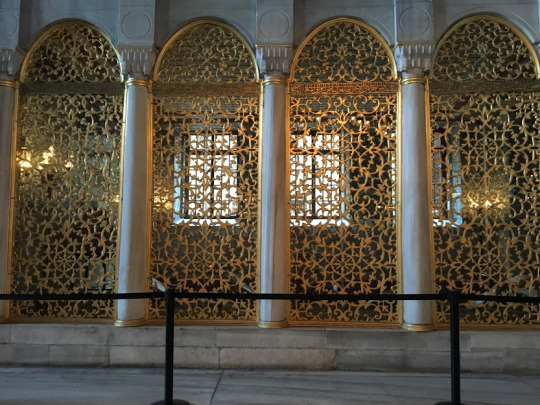
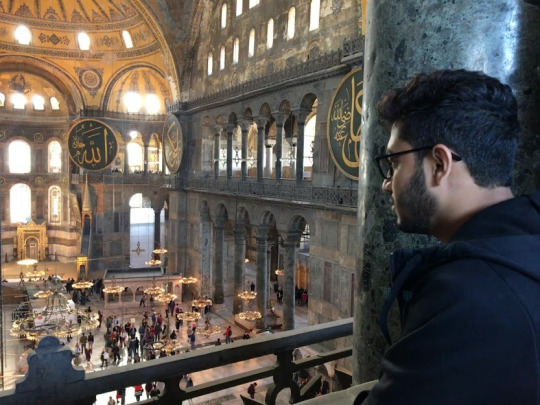
Pro Tip: Get the ticket for Ayasofya, Topkapı and Archaeology museum together for 135TL instead of getting them individually. All are worth a visit.
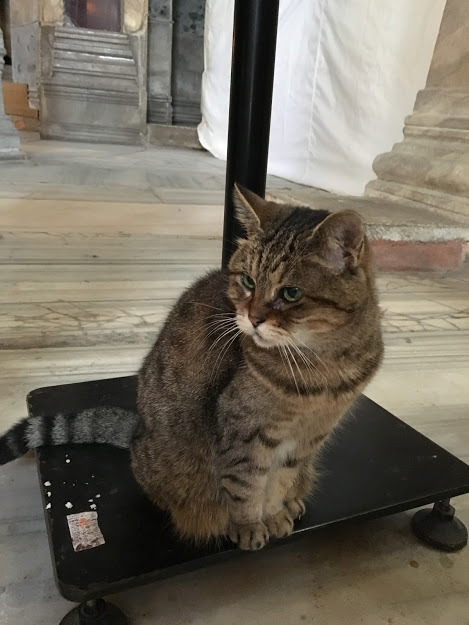
Hey kitty kitty! Istanbul’s cats, like her Sultans, are fat!
Blue Mosque, the second jewel of Sultanahmet sitting right next to Ayasofya, was unfortunately under renovation, so a lot of it was covered. We managed to witness some of the famed Iznik tiling anyway. Note how this and all of the other mosques in Istanbul, and in fact the rest of the Turkey, are influenced by Ayasofya. One interesting thing we noted was that the instructions outside the gate urges the visitors to refrain from, among other things, kissing inside the Mosque. Helpful tip.
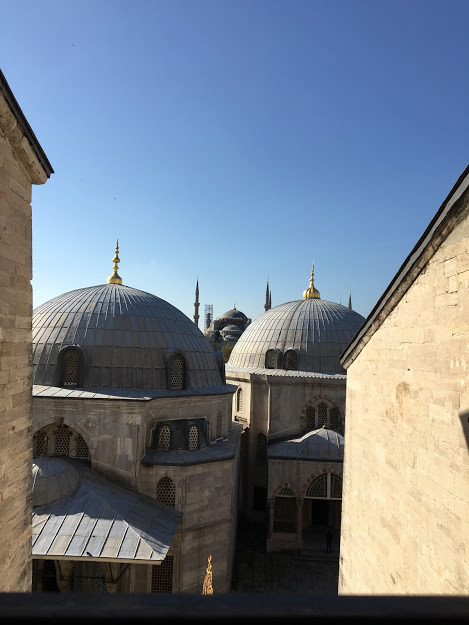
Blue Mosque seen from Ayasofya window
The fame of Blue Mosque, or Sultanahmet Mosque (Camii, pronounced Jami. Similarity with Hindustani to be noted) somewhat eclipses that of Suleymaniye Mosque, named after Suleiman the Magnificent, the ruler during the golden ages of Ottoman Empire. That should not dissuade anybody from paying it a visit, because it is indeed at par with its more famous counterpart, and lot less crowded. We obviously enjoyed it more because of the restoration at Blue Mosque. The minimalism and unassuming nature of the interior complements the huge size of the interior. Free pamphlets and small books explaining Islam are distributed inside, and we helped ourselves to some.
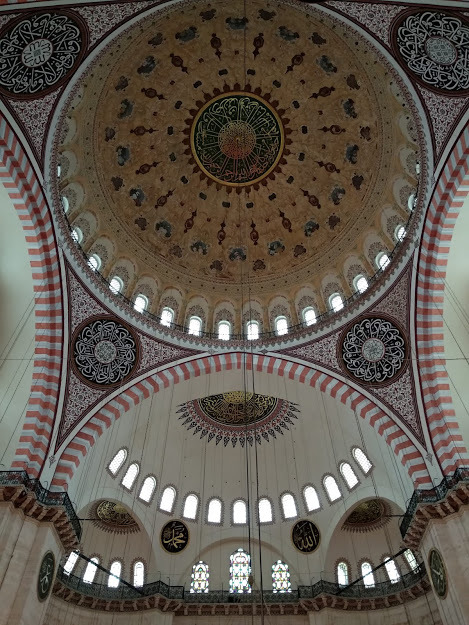
Walls of Suleymaniye Mosque
Steamy
At night, we decided to try one of those famous Turkish baths, or Hamam. Most hotels will know who to call for their customers, and Mihriban hooked us up with Gedikpasa Hamam, somewhere in the mesh of cobblestoned streets, touristy hotels and heritage structures that is Sultanahmet. It was pretty cool because I had read that it was one of the oldest Hamams that still existed, probably the oldest, as it was established by the eponymous Pasha in 1453. Turns out, they have a pick-up from and drop-to service, and a big van pulled up in front of our hotel. We climbed in, and off it went, cruising confidently like it had done before umpteen times through the narrow lines and sloped terrains to an old establishment with a facade that might render it inconspicuous among the densely packed shops and restaurants, but on entering you will find yourself amongst a relic, a living history.
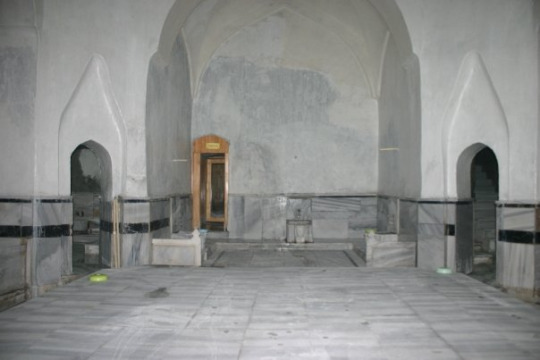
You are told about the various services by the receptionist, like you can use the Hamam yourself for about 80 TL, or you could get a foam bath and massage from a staff for 120 TL. For a few more bucks, you could get a honey massage, but we didn’t fancy it that much. You are led to a room where you keep your belongings and change into a towel,and tie the key on your wrist. After washing oneself, one enters the steam chamber.
The steam chamber, the actual shvitz, has marble flooring and plastered ceiling, which is dome shaped, and an aura of antiquity that makes you realise that you are sharing a public bath with 550 years of history. This feeling, perhaps encapsulates the entire spirit of Sultanahmet and Istanbul itself. The warmth of hot steam soothes you from the cold of outside, and the steam feels cleansing, although one’s breathing becomes a tad bit belaboured due to the temperature and steam content of the air. Soumya rushes in and tells excitedly that there was a guy who just took of his towel in the corridor without a care!
And soon somebody came to take out ours. An old gentleman, whose name I couldn’t catch because of the language and accent barrier asked me to sit in a corner, near a tap with a basin below it created out of a parapet of diminutive height. He started rubbing me with the foam HARD, as if trying to wipe away my epidermis. Tiny, black-brown, spindle shaped dirt started to roll away as he pulled back his hands during the violent rubbing, leaving a pink skin it its wake. He did this on the limbs, and then in the central raised floor, made me lie down, and removed my towel. For the briefest moment, I was fully in my birthday suit, lathered up it was far, far from being sensual. I also managed to catch another gentleman getting the same rubbing down. Only he was upside-down, with towel covering the valley between the hills, making it perfectly clear what awaited me. The awkward agony ended when the gentleman rearranged my towel to closely cover the unmentionables, and begin the intense massaging that flitted around the boundary of pain and pleasure. Then he overturned me and proceeded with my back and sciatica. I was able to muffle my screams of agony/ecstacy, but Soumya was crying (moaning?) out loud in response to his masseuse’s strong hands.
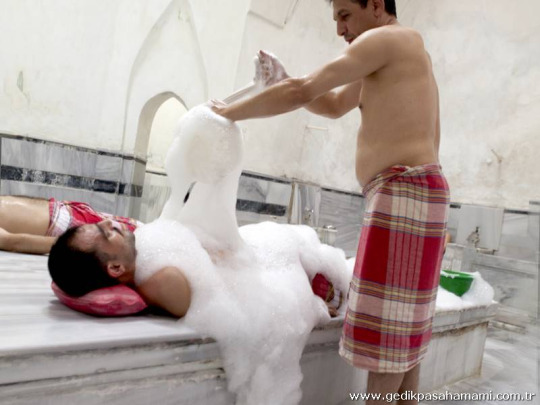
A file photo from the Hamam website
At the end of it, he took me back to the bathing place and cleaned off the foam. Shook hands with me and said something with the word 50. Either he was talking about his age, or about the tip (Which would have been too much, almost half the cost of the whole service).
After one is done with steam and massage, one can wash it off and cool it in a green pool in a cave like niche, finishing off a wholly tranquilizing experience in a high.

The Tale of Two Palaces
Topkapı Palace is actually a Royal complex, with multiple courtyards having buildings and rooms that served various royal functions: schooling, receiving diplomats, circumcising princes, meeting general public. Standard stuff. The highlight of Topkapı though is the one room where they don’t allow photography: The room that contains artefacts that are believed to be personal belongings of prophets in like Moses, David, Abraham, and Muhammad. It also has sacred relics from Kaaba including the door for the Kaaba. The caliphate passed on to Ottomans after their conquest of Mecca in 1517, and they brought in many holy relics from Mecca to be stored in Topkapı, including dentures and hair of Prophet Muhammad.
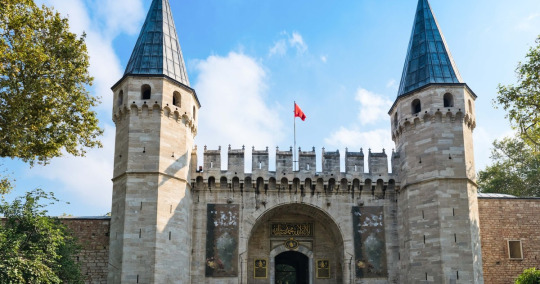
Courtesy: getyourguide.com
One gets a peak of the lives of Sultans in the empire from visiting the harem. Harem is the private part of the palace, and is where Sultan, his countless mistresses and the head of the household, the Valide Sultan or Sultan’s widowed mother lived. There is a separate ticket for Harems in all palaces, about 30 TL. A package deal may cost less, so take it. Since any given Sultan with his countless harems is bound to have many children, all equally entitled to the throne, almost every succession involves fratricide i.e. potential successor killing off all of his brothers to establish his succession. After Mehmed II, as I learned later through fascinating Wikipedia (back home) and Quora articles, the practice was even codified and considered a rite of passage! As I looked at the corridors, the walls, the exquisite washrooms and the magnificent rooms, I could not help but wonder of all the drama and palace intrigues that would have taken place in the harems with their shehzades, Valides, concubines, wives,eunuchs, soldiers and assassins maybe?

Panorama of the entrance

Famed Iznik tile works
One of the most remarkable dome interiors in the beautiful white dome of the library. Mesmerised, we spent longer than usual staring at this stunning dome. As mentioned earlier, the main decorations in the palaces and mosques are accomplished using tiles and carpets since representation was not allowed. There are 1-2 paintings in the administrative chambers though, that too miniatures.

The Library dome
Topkapı is located at the tip of Fatih area overlooking stunning views of Bosphorus. This makes slightly overpriced restaurant at Topkapı, Konyali, worth a try, because as you can see, it makes for a kickass picture.

Bliss atop @ Konyali restaurant
For all its glory and its size, Topkapı is still somewhat...humble. Of course, it is very difficult a claim with your gates, size, views and separate rooms for shehzade’s circumcision, but if you compare it with a typical European palace, like say The Hermitage of St. Petersburg (of which I have only gone through a coffee table book), the palace complex is unassuming and not grandiose.
This realisation strikes you only when you visit the Dolmabahçe Palace. Sultan Abdulmecid I had a somewhat similar idea, and decided that he deserved a palace just like his European peers elsewhere, even if it costed the empire a quarter of its tax revenues that year. The financial hole that the palace made contributed to the empire’s nickname as ‘the sick man of Europe’.But what a hole! The tourists with a 90TL combo ticket (Muzekart, in case any overplanned enthusiastic tourist has taken, is not accepted here) would certainly say it was worth it.

The European style imposing entrance
Dolmabahçe means ‘filled-in Gardens’, and before entering the palace after the majestic entrance, you do see beautiful gardens all around. Do take a lot of the photos, because inside photography is not allowed. My friend tried to take some, but was spotted by the guards,who only asked him politely not to do it again. Because not taking photographs when you see something like Ceremonial Hall at the end of the palace tour is just a shame. So here is an image with bent perspective of the impossibly huge hall with a chandelier that was a present from Queen Victoria, because I suppose it is impossible to capture the grandeur of the entire hall in a single frame. Places like these make you feel like staying longer because of the mild fear that there is one bit of detail you might have missed out.
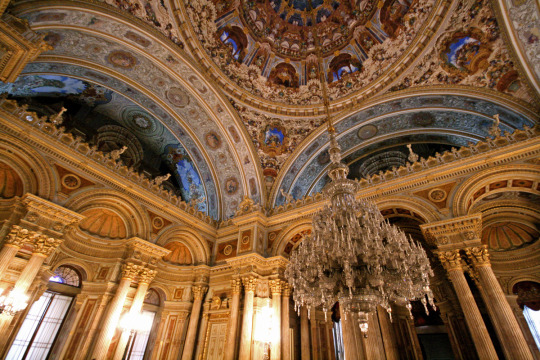
Ceremonial Hall
Dolmabahçe palace is not administered by the Ministry of Culture and is not a full museum, but is administered by Ministry of Palaces, because it is an amazing venue for hosting important summits and State dinners.
The highlight of Harem tour, that is after the palace tour, is the bed draped in National flag where the father of the Turkish Republic, Kemal Ataturk breathed his last. The clock by the table indicates his time of death. Every year, at 0905 on 10 Nov (Just 1 day after we left, because I did not know of this), the entire nation comes to a standstill in remembrance. Check out a link I have provided at the end and be amazed with the respect he commands. Also, it is recommended to read up about Ataturk, a fascinating figure in the 20th Century whose ideas about secularism in a 96% Sunni Muslim country that once held the keys to the Kaaba are at the same time inspiring and polarising and a bit of a cautionary tale about repercussions of imposing radical changes into a society.
Pro Tip: When I asked for Turkish Coffee with sugar, they gave me a small Lokum (Turkish Delight) with it. It was covered in powdered sugar, so foolishly I put it in, before realising my mistake. So, don't do that. The right way is to take a sip, then take a bite and so on. I had to fish it out with the stirrer. Fortunately, it was still very, very delicious.
Dolmabahçe is out and out a European palace, a far cry from spartan austerity that is the hallmark of Islamic teachings. It was so overwhelming that we did not possess any more mental strength to go see the painting halls consisting of the works of art commissioned by the Europe loving Sultans and many by the last Caliph, a patron of arts and a painter himself, Abdulmecid II. History buffs will be interested to know that this Caliph’s ousting prompted the Khilafat Movement in India during the WWI. We then headed to ‘check off one of my items on bucket list’, however cheesy and corny it might sound.
Kemal and Fusun
Orhan Pamuk is a divisive figure in Turkey. His Nobel win is touted by many as political, to force the hand of the state in the suit against him claiming he insulted the republic by recognising or hinting at Armenian Genocide. He is a somewhat liberal figure, not liked by nationalists in general. Mihriban, our hotel receptionist, guide and friend also stated that she disagrees with the politics of Pamuk, but seemed fascinated by the idea of the museum and wondered why she never went there.
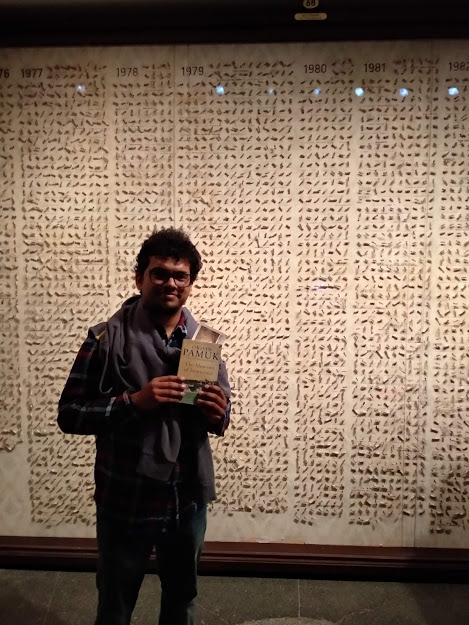
Me with each of the 4000 cigarettes that touched Fusun’s lips and had a mark of her lipstick to show for that. Pamuk’s protagonist is a melancholic, lovelorn, a a teeniest bit creepy (at least by today’s standards)
For people like me, borderline fanboys, we love his fascinating depiction of the mundane and his brilliant analysis and exposition of a nation struggling with its Westernising aspirations and traditions, and his exploration of a city that has a hankering for everything European and longing for the glorious days of the empire. My Name is Red and Istanbul: Memoirs of a City (that I read after coming back) are highly recommended.
Museum of Innocence is also a similar work where the protagonist who is somewhat like the author himself, belonging to the ‘society’ that shuns everything traditional and lives among the cocktail parties and fancy luncheons and everything else Western, falls for his cousin, a girl from a traditional Muslim family living in a crumbling middle class neighbourhood. Kemal has a bit of kleptomania which he likes to call his fascination with ordinary items, and everytime he visits Fusun’s house, he steals a small item from there. Eventually his collection grows so large that he makes a museum out of it, dedicated to Fusun. Orhan Pamuk made the exact museum with every item Kemal ‘stole’ in the book at the location where Fusun’s family ‘lived’. This fascinating concept of a museum complementing a book makes it a must visit if one admires Orhan Pamuk. What more, if you have the book, then your entry is without fee, and on a particular location in the book, there is a box where they stamp it. The book keeps referencing the museum and this stamped space is indeed a part of the story, making the book and museum complete in themself! Each chapter in the book has a shelf with exhibit dedicated so a Pro Tip: Buy an audio guide for only 5 TL. Each exhibit is explained by Orhan Pamuk and an actor essaying the role of Kemal (Yes, Orhan the author indeed makes an appearance in the book. As I said earlier, the book is complete in itself).
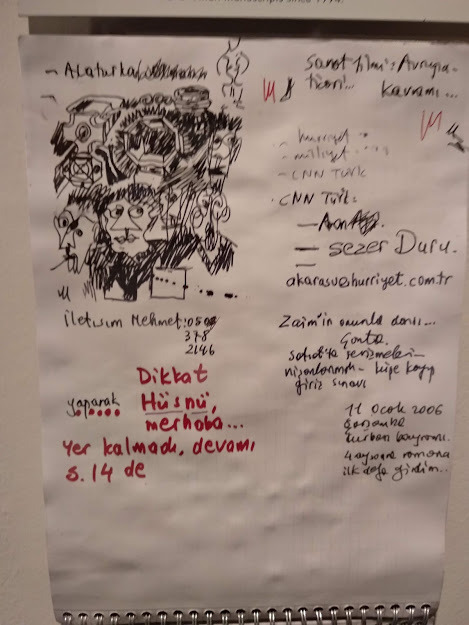
Pamuk’s scribbles
It is recommended that one visit the website of Museum of Innocence to check out Orhan Pamuk’s idea of a Museum.
The Most Instagrammable Neighborhood
Karaköy is probably called that because of its interesting graffitis, mesmerizing cobblestoned narrow alleys and the Galata Tower that rises from the middle. Travellers are forewarned that there will be a huge line at the Galata Tower in the peak season. But once you get on the top, you know why.
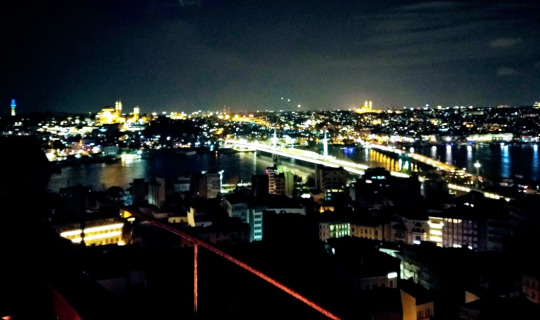
Galata Tower was built in the Genoese colony as a sentry tower and also as a tower to forewarn about any fire incidents in the city. So it is ironic that the tower itself fell victim to fire, and that is one amongst the umpteen times the tower has been damaged and rebuilt. It is now the primary fixture of the Golden Horn and the Istanbul skyline, and from the top, one can see all of Istanbul, from the Topkapı Palace, Ayasofya and Blue Mosque on one side to brightly illuminated 15 July Martyrs Bridge (formerly called Bosphorus bridge, renamed after the 2016 coup attempt) on the other. We climbed (rather, took an elevator) on top in the evening, in a crisp and beautiful weather, and then something fascinating happened: multiple Ottoman style mosques interspersed across the city start playing the Azan with remarkable synchronization. There are few experiences that are as unforgettable as this one, and this indeed is a quintessential Istanbul experience. It would have been nice to have a çay(chai) at this moment, but we took so much time to soak up the views of the strait and the streets (remember the FOMO anxiety we talked about in the palaces section?), that by the time we went inside to the restaurant at the top of the tower, it was closed.
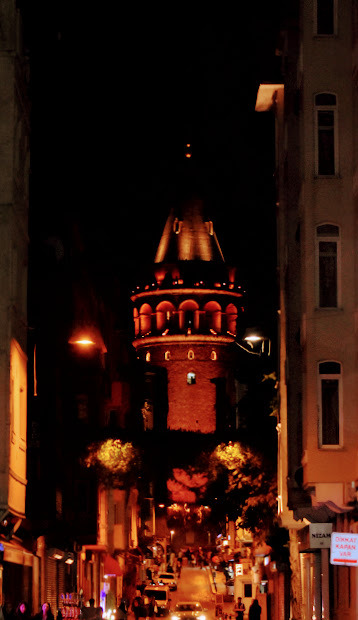
Galata Tower
There was a 4D Istanbul tour waiting for us downstairs on the 3rd floor though, which takes on this simulated helicopter ride across and inside the major landmarks in the city. It’s fun, despite of it sounding a bit pedestrian (I am talking about the population that finds things like these and roller coasters nothing more than gimmicky); go for it.

The other thing that one must do in Karaköy is simply walk around and soak up the sights and sounds. And eat a delicious, mouthwatering, big baklava at Karaköy Güllüoğlu for 25 TL. Syrupy, crispy, filled with pistachio nuts, one must definitely savour as much baklava as one can while in the city.

Mouthwatering Baklava at Karaköy Güllüoğlu
To Black Sea and beyond
No textbook Istanbul trip is complete without a ferry ride across/in the Bosphorus. Bosphorus, after all gives Istanbul ALL of its identity. Everything that the place is, it’s because of the strait. The strait joins Black Sea and Mediterranean Sea through the Sea of Marmara and The Aegean, making it all important and a prized possession. The location proved so strategic that more than a dozen sieges were attempted on the city, before Mehmed II actually achieved success. Thar is why the Greeks, the Romans, and the Ottomans wanted a piece of it, why Prophet declared that whoever conquers Konstantiniyye is the most blessed. The strait is a clear boundary between the great continents, and more importantly great cultures of Asia and Europe, of Orient and the Occident, and Istanbul is the meeting point, the city with the dual identity. The city is testament to the fact that much of human history, culture and language is all about geography.
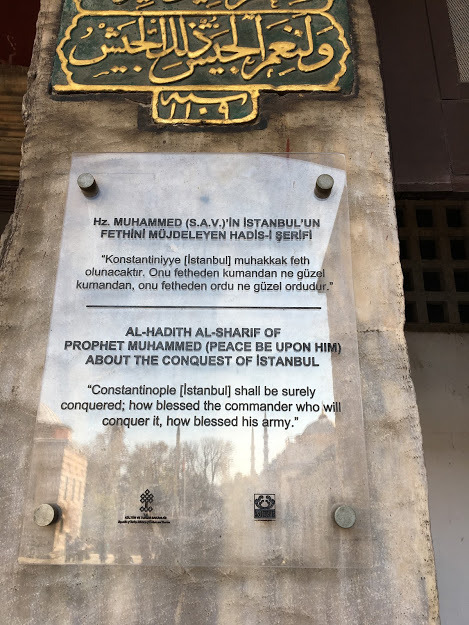
Muhammad’s proclamation on the blessed conqueror of Constantinople (Place: Ayasofya)
So, Bosphorus Cruise. On Sultanahmet, many will try to sell you a cruise that will make a trip of the strait, the golden horn, will have a buffet, all for €20. Or there is the famous Big Bus Istanbul tour where they will take you to an all day tour of all the Istanbul places and a cruise for €30 or 60. You can go for the latter if you are on a layover trip. You can ignore the former; never too good an idea to go with the touts. You can get all the information about a cruise with food and entertainment for €20-60 from the front desk of your hotel, a very good reliable source of information, and even better if you have a rapport with the receptionist.
Or you can rough it out (not really) and make use of one of the most bang for bucks public transport service (details of Istanbul public transport network will have a dedicated section; don’t worry): Şehir Hatları.
Şehir Hatları is the City run ferry service that, apart from its regular services to and fro the opposite banks of the bosphorus, also runs a 6 hour cruise all for, drumroll please, 25TL! There is one cruise per day and it picks you up from the Eminönü docks at 1000 hrs all the way over to the village of Anadolu-Kavagi near the Black Sea and brings you back by 1630.
The cruise itself was sparsely occupied, probably due to tourist season ending. Which is a boon because in peak season, the cruise gets full pretty quickly. Waiting on Eminönü docks for our ticket we met this guy who had a giant parrot on his shoulder, the size of which freaked out Soumya. He placed the parrot on Soumya’s shoulder and offered that we click a photograph for 15TL I think. We politely refused, so here’s a stock photo.
The ship had 3 floors, with lower deck having cushioned benches and table a la a classic American diner, with a small stall serving snacks. The mid and top deck were outside, and if you can tolerate the cold, cold breeze, you will see sights unparalleled. As Hagia Sophia, Blue Mosque, Suleymaniye mosque, and Galata Tower to your right seem to get farther and farther away, you get to see the iconic Istanbul skyline which I can never get used to. The first stop is Üsküdar on the Asian side. This neighborhood, considered a bit conservative as opposed to the more liberal and open European side, is famous for its sunset views, which we missed by a few minutes on our last day, but still enjoyed çay along the banks, where many had set up cushions for tourists and lovebirds to enjoy with Bosphorus views.

As we approach Karaköy, the view is dominated by the imposing Dolmabahçe palace. Along the way you pass 2 of the three bridges that connect Europe to Asia, numerous Bosphorus mansions called Yalis and the castles of Rumelihisari and Anadoluhisari. I did not know at that time, but Rumelihisari or Roman Castle was built by Mehmed II as a sister castle to Anadoluhisari which was on the opposite banks, and together acted as a throat or strait cutter, cutting off the rest of the city before laying siege. Other notable sight were those of gargantuan cargo vessels that sailed by and the seagulls that competed with our cruise, making use of wind currents to float and making loud noises. You will always find these noisy creatures chasing a ship, probably for food, and the Bosphorus is filled with these seagulls; they are what pigeons are to our cities: a regular feature that are sometimes just pest.

Bosphorus Panorama
Our last stop in the onward journey is the tiny fishing village of Anadolu Kavagi, which is directly opposite to the penultimate Rumeli Kavagi. The word Rum is used to denote Roman Anatolia or simply Roman or Rome. The Ottoman Padishah used to have the title of ‘Kayser-i-Rum’, the descendant of the Romans, and omission of this title in diplomatic communication was casus belli, or cause of war. The famed Sufi saint and poet Jalal ad-Din Muhammad has the title ��Rumi’ attached to him because of his place of operation, in the Anatolian heartland., specifically Konya, an overnight journey from Istanbul by road. Although he is also known by the name Balkhi, placing his origin at Balkh in what is now Afghanistan.

Seafood at AK. Most good restaurants serve a basket of bread by default, a complementary feature. Water, you gotta buy separately.
At the AK, you have a stoppage of 2.5 hours to feast over some delicious seafood (yours truly refrains from meat and prefers to enjoy it vicariously) and visit the Yoros Castle, an outpost built by the Thrace as a strategic watchtower. The village is now occupied by the fishing community and the Turkish Armed Forces. Once you start walking around searching for a place to eat, as in any other Istanbul tourist area like Sultanahmet,the restaurant maitre-d’s (if they can be called that) start to cajole you for your patronage. We chose a seafood place with nice Bosphorus view, and as recommended by the immaculately dressed waiter, ordered a fish and something vegetarian that you don’t care for anyway (although there are good vegetarian options in Turkey). And we ordered Rakı .
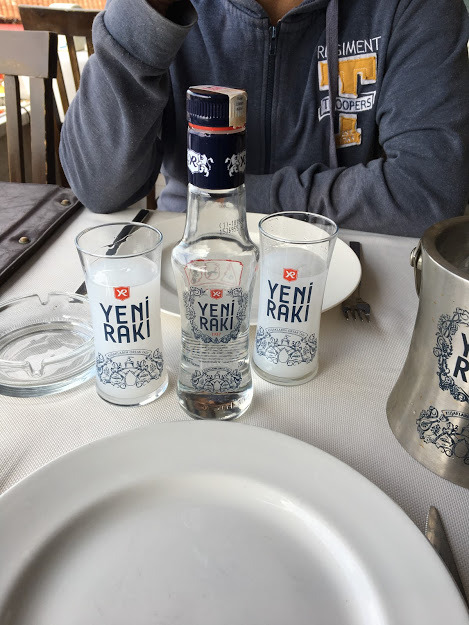
Rakı
Rakı is Turkey’s national alcoholic beverage made from rice and has a strong anise or saunf taste. One dilutes the Rakı with water and it turns white from colorless! Soumya exclaimed that it looks like a local beverage popular in Orissa called Handiya.
And it gets you drunk fairly quickly, leaving you in a happy merry kind of stupor that fortunately or unfortunately dissipates within an hour. We were laughing uncontrollably, consuming the lunch extra slowly and by the time we sobered and paid up, we had already spent an hour and a half in the restaurant. Which maybe commonplace in Europe but for the Indians, almost unheard of!
This left us just about half hour to climb up the hill and visit the Yoros castle (fully sober by then, by the way). The castle itself lies in ruins, but the views of deep blue strait that merges into the Black Sea, and the beautiful Yavuz Sultan Selim bridge that straddles the waters gave us the aforementioned FOMO as the time was running out and we would be in trouble if we missed the ferry.
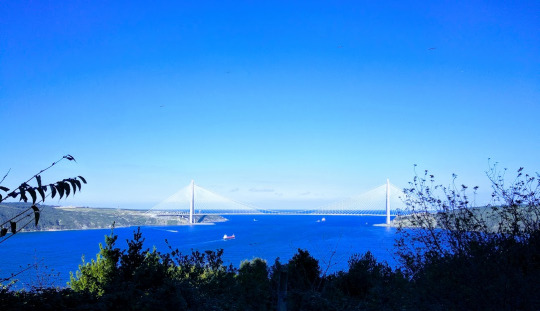
The hastily clicked Yavuz Sultan Selim Bridge. The water body beyond is Black Sea!
The return was mostly spent in soaking up the scenery and staring at the seagulls.
The Ice Cream Trick
Dondurma is the Turkish ice cream made of a resinous substance that allows it to stick to a surface and defy gravity. This enables the ice cream guys to perform that trick where they pretend to give you the ice cream but snatch it away, drop it but really it sticks to the big handle, do this 3-4 times before handing the ice cream over.
So then, at Taksim Square where we are being entertained by this ice cream cum performance I told Soumya in hindi that let’s play the same trick and give him money but take it back. The guy sort of read our mind and pointed at a spot in the table saying ‘Put it here. I have been doing this a long time.’ Ah damn!
Another performance with food we saw was at a Kebab place in Sultanahmet where I ordered a vegetable hot pot, which they served with a sticky rice. They filled the earthen pot with the veggies like mushrooms and put it up on a small stove of smoldering coal, brought it to us and did a little performance before hitting the top of the pot, and off went that piece of pot flying. You will see this trick being performed in many restaurants in Sultanahmet.
Touristy things are fun, who knew.
Find the link to a Dondurma trick at the end. Keep searching for more, fun way to waste more time on YouTube.
Pro Tip: For the vegetarians out there, plenty of mediterranean salads like abaganoush are available in almost all restaurants. Or do what I did in a small restaurant near Cemberlitas: Ordered a chicken roll without the chicken!
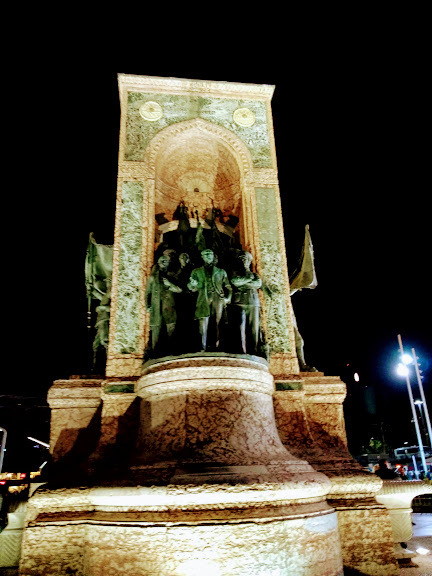
The monument to the Republic at Taksim Square. The gentleman at the front it Mustafa Kemal Ataturk.
So we boasted (or opposite of it) to Mihriban that whatever crowd she thinks we will encounter at Taksim, it can never be as bad as India, because well we are the crowded country, aren’t we? We were proven so wrong at the historical Istiklal Caddesi or Istiklal Avenue near Taksim. Generally we did not find Istanbul crowded, but that may be attributed to the end of peak tourist season. But the crowd at Istiklal Street on a weekday was comparable to the crowd at, say, Connaught Place or Chandni Chowk! The street is lined with Ottoman era buildings (European style, so perhaps late Ottoman, when European influence became marked), shops, restaurants of all kinds-doner kebabs to your KFCs and Burger Kings, intriguing street performances here and there, and the classic Taksim- Tünel tram line. While the trams running in Istanbul, used for commuting, are all fast and modern built by Alstom, the Taksim- Tünel line has been kept mainly as an attraction, the slow old trams of the olden days. There is just one coach that does the up and down from Taksim to Tünel, and it is crowded by tourists who want the touristy experience of the Old Istanbul. We decided to skip that and just walk the whole way, from Taksim to Tünel and beyond. At Tünel, you have the Funicular line, which is essentially 2 coaches on a long looped rope and pulley mechanism such that when one coach goes up the other goes down. Mainly used to go up and down a sloping, hilly area.
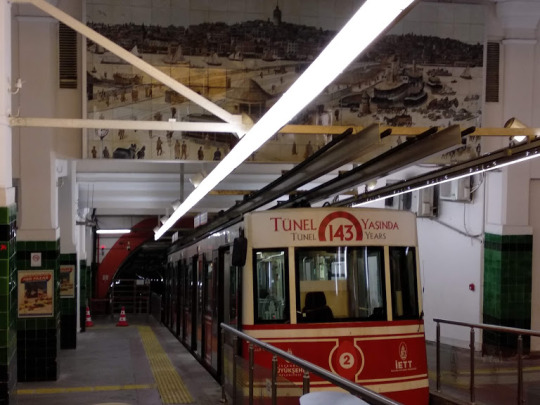
Historical Funicular at Tünel
There are streets that branch out of Istiklal with interesting restaurants, all having a musical performer to entertain their guests. Unfortunately the restaurants are so close that you can here 3-4 guys singing loudly at the same time, resulting in utter cacophony!
We managed to find a vegan Lebanese restaurant in the street, and had delicious falafels there.
The People We Met
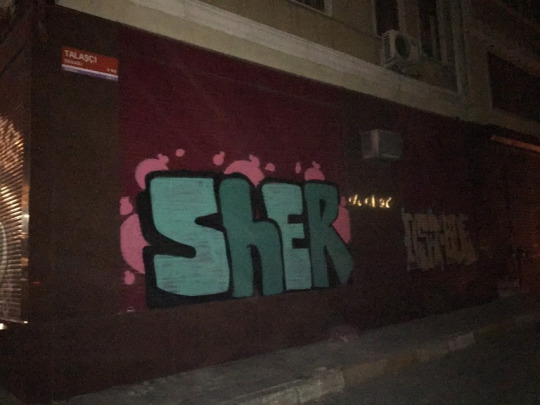
Graffiti we encountered on a walk in Beyoğlu
One important component of travel to a place is the people one encounters or meets. While I myself have difficulty in opening up to strangers, it helps if I have a slightly more outgoing companion or a person easy to talk to.
Which is where Mihriban, our 30 something Kurdish friend from Ankara who has a degree in Turkish Literature, likes fitness and does not like Orhan Pamuk, and has a disarming style and persona comes into picture. She also very kindly took us to Suleymaniye Mosque, shop at Mahmut Pasha and the nearby more famous grand bazaar, and a rooftop coffee with lokum with views of Golden Horn and Bosphorus, which the reader may tire of but I most certainly did not.
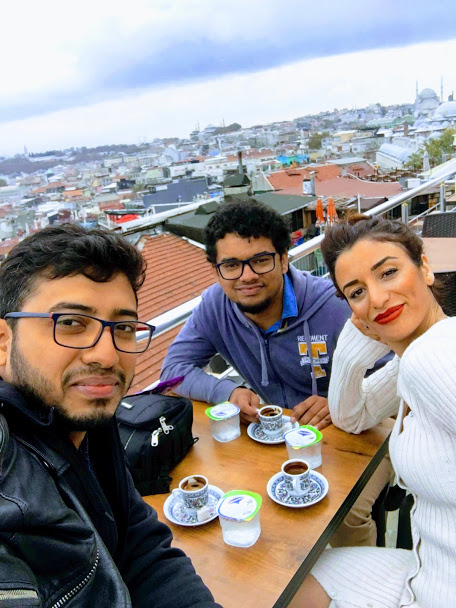
Turkish Coffee at a rooftop joint
One stop at Mahmut Pasha we took was to buy some Shawls, beautiful silk ones which I later learnt were called stoles. I realised that I was bad at picking clothes for women when Mihriban pooh-poohed almost all of my choices (Thank God). After shopping for a good 8-9 stoles between the two of us, the shopkeeper decided to offer us some çay (tea), instead of giving us further discounts. In a typical Indian manner, we finished the tea while Mihriban had not even reached the halfway mark. This led shopkeeper to exclaim in surprise that we finished it off way to quickly, and Mihriban interjected that we must savour things more deliberately.
From the crowded Mahmut Pasha,filled with vendors selling all the varieties of lokum possible, we moved to the Grand bazaar, another quintessential Istanbul attraction with vendors selling everything from lamps to carpets to tiles to lokum to spices-you know, your typical Oriental market, only way expensive. We did get our hands on some beautiful Iznik tile coasters at Iznik Works in Grand Bazaar. The Iznik form of ceramic pottery originated from the Iznik towns and was very much in demand by Ottomans to decorate their palaces and mosques. Be it Topkapı Palace, Suleymaniye Mosque or Blue Mosque, you will find these tiles adorned as mosaics everywhere.
For some reason, we decided to lunch at the Burger King at Cemberlitas, and I had the one vegetarian option available on the menu- a bean burger. It was yum.
ProTip: There are types of Lokums that I gather are available. One is a slightly cheaper one that resembles those dense gelatinous halva we have in India. The other types are more expensive (100TL for a kg) that are filled with variety of nuts and have richer flavour diversity. Buy them either from franchise stores like Mado or Hafiz Mustafa or explore on your own, in Sultanahmet, Mahmut Pasha, Grand Bazaar, or that bazaar near Blue Mosque. Also eat tons of Baklava, an advice worth repeating.
ProTip: Much to my frustration, during a bit of googling for this piece, I discovered that Zomato operates in Istanbul! What! And oh, by the way, Wikipedia is banned in Turkey. This I discovered only when I returned. That’s why I was not able to open there.
Mihriban also used to make çay for us in the evening when we had returned from our trips, and we would discuss about religion, cultures, exercise, family, living in Istanbul, and how Istanbul is the number one destination for bald Arab men to get hair plugs (You see a lot of bald men with bleeding head or head covered with cotton) and so on. Mihriban’s demeanor brought in many friendly guests of the hotel, and one such was a wise old man from London called Abu Bakr John, who came with his wife Hatija. Abu-Bakr was a Mauritian immigrant to London, and had a little bit understanding, at least an inkling of Hindi, because obviously his forefathers were from India. His wife Hatija adored Shah Rukh Khan, just like Mihriban adored Aamir Khan. Mihriban claims to have seen all of his movies and to prove her claim, she referenced the giant colorful ass-chairs the three protagonists of ‘3 Idiots’ sat on. Then we proceeded to talk about the latest bollywood film she watched, ‘Padman’, and I showed her the TED talk of the actual Padman, Arunachalam Muruganantham, on Youtube with Turkish subtitles, which she found pretty delightful.
We also talked about the Turkish TV viewing habits, and how Turkish people prefer watching Indian soaps over local fares, which is more popular in Azerbaijan (Azeris watch Turkish soaps, Turkish watch Indian series, Indians watch American series and Americans just watch their own!) Also, Mihriban, and by her I guess most of the Turkish TV viewers, think that the streets on India is filled with cows, the cows that we worship, which she found amusing. I can’t say I don’t agree with that stereotype.
We also tried to chat with a bunch of Moroccan ladies from Brussels in the lobby. The trouble was that they knew only French and Mihriban had to use Google translate for the simplest of the things. We were also talking about Muslim marriages and the concept of Mehr when the Belgian lady asked whether we were Muslims. I said no. We tried telling her, probably through google Translate that we were from India and we were Hindus, and she just replied “Buddhists?” We nodded and just left it like that. While retiring for the night, we were talking about how difficult French was and I tried to pronounce ‘Au revoir’ as O-re-vwa. One of the Belgian ladies heard us and said what I thought was ‘Au wa’. The guttural r is simply not an Indian thing.
Transportation
This is a Protip chapter. Much to the annoyance of many, I have a love for efficient public transport. And Istanbul’s has one USP: Integration. From Ataturk Airport, if you have to go to say Üsküdar, you can take a taxi that will drive you all the way to one of the Bosphorus bridges and drop you there, and charge a bomb. Airport transport from our hotel, which is on the European side, same as Airport, takes €60, which is astronomical. The cheaper and more pleasurable way is to take a metro from the airport, change at Zeytinburnu or Yenikapi to the tram, take the tram to Eminönü Tram station, cross the road to the Ferry station and hop on to one of the Şehir Hatları cruise. And it is fast with no hassle. Metro has a frequency of 10 min, tram of 2 and boats of 30, and purchasing an Istanbulkart at an automated dispensing machine at every bus, tram or ferry station, which is just 6TL, and rides that are equally nominal means you have covered 20+ km journey in 15-20TL! The transport system that connects the massive city integrates Metro, Bus service, Tram, Funicular, Ferry, and an undersea train service called Marmaray (which we unfortunately did not try).

Istanbul Transportation Map. Zoom/open separately for clearer view.
The Alstom built trams are ridiculously fast and modern, except the antique one at Taksim. Therefore, be careful when you cross the roads.
TLDR
Hotel: Best place to get a hotel if you are in Istanbul for the first time and if you want to visit all the sites is of course the Sultanahmet area in Fatih district, as major old city attractions are all within walking distance, there is a seaside promenade nearby for sunrise/sunset strolls/jogs, and lot to eat! We booked at Harmony Hotel Istanbul, a cozy hotel with free executive breakfast, a spacious balcony and lounge with great sea view if you get top floor.
Tipping: Something Indians are not too attuned it, but is expected outside. We stuck with the 10%-20% almost across the board (towards the lower side of that range we must admit.) Most places have a tip box where you can contribute.
ATM & Currency: International Debit Cards are accepted almost in all ATMs. Withdraw from ATMs of known international banks or Turkish banks like AKBank or DenizBank. Remember, they all charge 3% conversion charge. Currency can be exchanged at the AKbank counter in the Arrivals of Ataturk airport, or at many exchange (Doviz in Turkish) centres in Sultanahmet, Grand Bazaar or Taksim. We exchange the €50 we had saved for the end of the trip at Ağaoğlu Döviz near Cemberlitas tram stop.
Sultanahmet Area: From Ataturk airport, catch a metro, change to tram at Zeytinburnu or Yenikapi going to Kabatas, get down at Sultanahmet stop. Walk around, it is amazing. See hippodrome with obelisk from Egypt (That was day 0).
Day 1:
Ayasofya or Hagia Sophia: 3 Hrs, 135 TL for combined Ayasofya, Topkapı and Archeology Museum Ticket. (Closed Mondays)
Blue Mosque: Free Entry, but do check out the timings.
Hamam: Turkish bath at Gedikpasa Hamam for 120 TL. Rejuvenating. Pickup from and drop to included in most packages. Contact front desk of your hotel.
Day 2:
Topkapı Palace: Separate tickets for Harem, but worth it. Get an audio guide. (Closed Tuesdays)
Gulhane Park: A park near Topkapı, beautiful, lush and has a mosque within for a prayer.

Day 3:
Istanbul Archeology Museum (Closed Mondays): For history buffs. Artefacts from Mesopotamia, Sumeria, Hittite, Phoenicia, Greeks and Romans.
Dolmabahçe Palace [Location: Karaköy]: Reach by tram from Sultanahmet, get down at Kabatas. Tickets to Palace + Harem is 90 TL. Audio guide is free and is also available in Hindi. Attractions are the European style grandeur, and the resting place of Mustafa Kemal Ataturk. There is an upper limit on number of people allowed, so go as early as possible especially in peak season. Also, no photography inside.
Museum of Innocence: Get down at Tophane Tram station, walk up a hill few hundred meters till you find a small house with vertical banner proclaiming itself as The Museum of Innocence. 40 TL if you don’t have the book, open till 6 (Closed Mondays). Guides available at 5TL with voiceover of the man himself.
Karaköy Güllüoğlu: Get down at Karaköy station and walk. Get a big baklava for 25TL.
Galata Tower: Walkable from Karaköy station. Keep walking towards that tower with the conical top. Roam around in the Karaköy neighbourhood. Expect a line at the Galata. The view is worth it. Also get the 4D ride at 13TL. It’s down at the 2nd floor though.
Day 4:
The Bosphorus Cruise: Starts at 10 AM from Eminönü docks, goes all the way to Anadolu Kavagi and back. Visit for the beautiful Cruise views, seafood and Yoros castle.
Day 5:
Suleymaniye Mosque: Walkable from Sultanahmet, or catch a tram to Bayezit. Sublime. Free reading materials on Islam for those interested.
Shopping at Mahmutpasa and Grand Bazaar: Shawl, lokums, carpets, tiles, lamps etc.
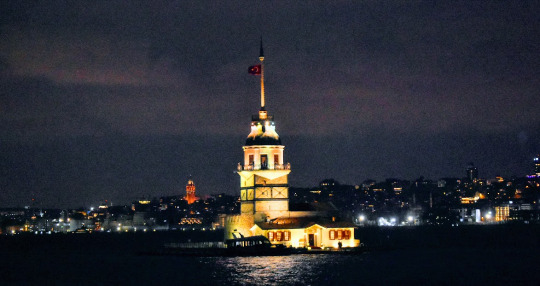
Maiden Tower or Kız Kulesi, taken from the Asian side. Galata Tower in the European side seen in background
Üsküdar and Kız Kulesi: Ferry from Eminönü . Visit for beautiful sunset if there are no clouds. Sip a çay as you enjoy the Bosphorus views. Kız Kulesi or Maiden Tower is not worth it.
Day 6:
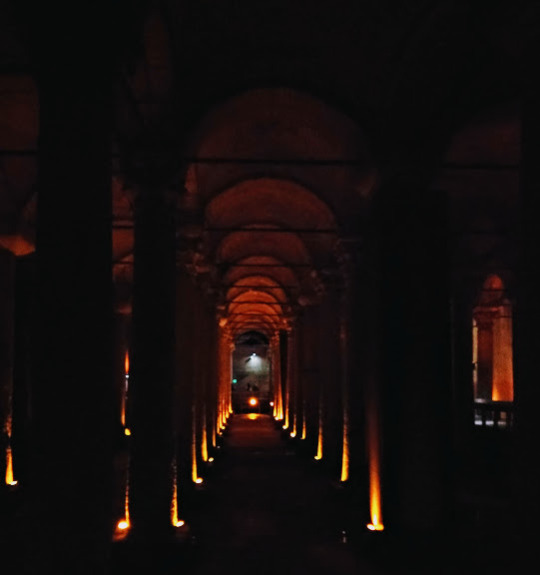
Basilica Cistern: In the Sultanahmet area, walkeable. Beautifully lit underground water reservoir dating to the Roman Empire. Visit for Roman architecture and columns with Medusa heads on it.
youtube
Commemorating Ataturk.
youtube
The Dondurma trick
0 notes
Text
Desire
//lil something i’ve been working on for about a week now.
Characters: Munya, Argost.
Warnings: Violence, blood, child abuse, mentions of drug use, slavery, human experimentation, body horror.
Summary: He was a child of the slums, orphaned and desolate. No one wanted him.

Monsoon season. The gentle pitter-patter of rain on the shacks and shanties around him filled his ears. There was a gentle breeze that rustled the trees and plastic tarps. The wind pushed trash into the creek forming in the dirt street. Despite being in a crowded slum of over a million people, the child felt alone. It wasn’t a disturbing solitude. He was content as warm water trickled down his back and legs. His life was full of people. He was packed into muggy concrete buildings with droves of other children just like him, where the humidity would make his skin stick and sweat. The long hours of work would make his head spin and fingers sore. The smell of human musk would be overpowering, and not even the large industrial fans in the factory could dispel the heat and discomfort. But here, he was free and alone. There were no blinding fluorescent lights here. No supervisors to yell and beat him for slowing down the production line. His only company was the sky, the rain, and the trees. They spoke softly to him through rustles and trickling. By the way the soft mud stuck to his tiny hands. They were not loud or angry or unsympathetic, but they were not eternal. He knew tomorrow he would have to return to the factory if he wanted to survive. He was a child slave, voiceless and orphaned. His name was Munya: desire.
Staying silent was the way to stay safe. Stay silent, work hard, and the supervisors would ignore you. The best response to shouting or punches was to be submissive and obedient. The proper response to his peers was silence as well. When they would tell him he was worthless, that he must be the son of a prostitute because of his light skin and red hair, it was best to ignore them. What they said was true though. He was a bastard. When he looked in the mirror, he didn’t see the dark hair and hazelnut skin of an Indian. He was pale and ghostly. His sunken eyes and cheeks didn’t look like they belonged to a ten year old boy. They looked like they belonged to a corpse. To a monster. Maybe that’s what he was. That was why his mother had given him up. That was why he felt so isolated.
He wasn’t stupid, unlike the other boys. So many were addicted to heroin. He sometimes saw the older junkies in the slums, laying on their sides in piles of rags. Some of the boys told him heroin made people sick. One boy shivered as he described it, eyes wide. Opium killed men; it struck at their hearts. The vomiting and fever killed them. That was why Munya told himself he would never take it, but he understood why the addicts did. The dirt and grime was suffocating. There was only so much starvation and ruin that one could take before trying to kill the pain. When an urchin like him walked down the street, he was a ghost. The more fortunate members of society had long since learned to avert their eyes. There were thousands of children wandering the streets just like him, begging at the heels of strangers. It felt as though he didn’t exist, because in the crowd’s mind, he didn’t. Sometimes he felt like there was nothing to live for. Even if it was through sickness, perhaps he should just let himself die. He could slip into the sweet embrace of heroin and sleep forever.
“It’s a very good job,” The recruiter said in breathless Hindi, ”Especially for a boy like you.”
Munya frowned at that statement. “Boy like you.” He felt the recruiter was implying something.
“They’re looking for boys who can do hard work for good pay. Better work then you’ll find in Mumbai, anyway. You’ve got a good amount of muscles? You fight?”
“No,” Munya answered bluntly. He didn’t like the way the other referred to him. It was like talking about a piece of meat.
“Ehh, that’s a shame… I’m sure they’ll take you anyway! You’re perfect for it…”
It was profitable, and Munya was homeless. He needed the money. The job was far away, but they would provide transport. Munya climbed onto a crowded bus with what few belongings he had: the clothes on his back, a pair of worn out sandals, a water bottle, and 185 rupees. Those around him were equally ragged. A thin coat of dirt lined every inch of the coach, crunching under his shoes. The bus rode out of the city and into a countryside Munya had never seen before.
“Name.”
“Munya.”
“Surname.���
“Don’t have one.”
“What?”
“I’m an orphan.”
The woman looked at the boy with distain and continued the questionnaire. They were in a stereotypical doctor’s office. What Munya would expect a doctor’s office to look like. She checked his blood pressure and heart rate. Reflexes. Cognition. Eyesight. Everything Munya could think of. At the end, he was escorted out of the office by a guard. After traveling through the labyrinth of the building, Munya noticed the subtle ring of distant yelling. The source of the yelling, he found, was a cellblock. Hundreds of men, women, and children caged like livestock. He stumbled backward in a daze as he viewed the scene. A mass of sunken, melancholy eyes stared back at him. Thirsty, cracked mouths were agape. Some were bandaged. Others mutilated. A few had missing limbs, and IV bags hung from the bars of their cages. Munya struggled and fought against the grip of the guard, but he, too, joined the mass of prisoners. How many, like him, had been lured in by promises of money?
The cell was sparce, cold, and white. There was only a toilet, a drain, and the floor. Paint chopped off the corners of the walls where many had brushed up against them. The air was hot and muggy, and the noise of the other prisoners didn't stop. At night, they shut off the lights, leaving Munya to huddle in the dark corner of his cell and watch the guards pass by.
In the morning, he awoke to the squeaking of his cell door opening. He made a rush for escape but was caught by two guards before he could even leave the cell. He felt a sharp prick in his neck and fell into unconsciousness.
“…The subject’s body has shown considerable change in morphology. Muscle mass has increased. Transformation is accompanied by changes in skin pigmentation and firmness. In some places, most notably the face and back…”
Munya felt a gloved hand brush up against his skin. It was as though he were asleep. The voices wafted into his mind, speaking some strange foreign language. His vision was black, and his body was heavy. Eventually the voices became clearer.
“Vitals?”
“They’re stable!”
“Oh thank god! He’s alive! I’ve done it! Finally!
“Just hold on, Vincent. We still need to check his cognition. He’s coming out of anesthesia.”
Munya’s eyes fluttered open to a blinding light. His vision was blurry. Two shadows stood over him, focusing into human shapes. His skin tensed and piloerected against the sudden cold of the operating table. He shifted, only to find his wrists and ankles bound. It was hard to find the will to struggle. His fangs clicked against each other in frustration. His fangs. Fear shot through his body and sent a jolt straight to his heart. Something was very wrong with him.
“Pupils normal and equal,” One man shone a flashlight in his eyes, ”Heart beat and breathing… I don’t hear any heart murmurs and ECG is regular. Breathing is healthy, too.”
Munya finally had the chance to look at one of the men that stood over him. A surgical mask, gloves, and lab coat adorned this one… And the other the same, along with a full mask. These were surgeons. Munya noticed a dull throbbing in his neck. In his spine.
Oh, oh god. What had they done to him?
“…Hello? Child, are you awake?”
Adrenaline pumped through his veins, propelling him to action. He struggled violently against the restraints. He had to escape.
“Vincent, Vincent! Do something!”
“Oh, what is he going to do, really? He’s strapped to a table—“
The boy tore through the restraints, launching off of the table. ‘Vincent’ screamed, stumbling backwards, and the other scientist fled the room. Munya threw his arms wildly, knocking over whatever equipment he staggered into. Scalpels, kidney dishes, and forceps flew into the air as he threw a metal table to the floor. The electrocardiograph fell to the floor with the sound of shattering plastic as he ripped the IV and cables from his body. A splash of blue arachnid blood flew into the air from his wound as he charged toward the scientist. His opponent acted in reflex, the sudden shock of terror triggering him to tackle Munya. Munya staggered but lifted the other into the air with ease, throwing him down.
The scientist sputtered and scurried to get up before Munya pounded his fist into the tiled floor. To the youth’s shock and amazement, the blow had shattered the tile, leaving a sizable dent. His discovery was interrupted as Vincent knocked him to the floor, grabbing his head in the motion. Claws sunk into his skin, drawing blood, and he screamed. In desperation, he kicked and struggled, but it was far too late to keep Vincent from slamming his head into the ground. His ears rang and vision blurred from the blow, but that all stopped when he was pushed yet again into the earth. Darkness.
He woke up in a cell, his feet and arms chained to the wall. For a moment, in the blackness of sleep, he felt content. He felt human. The scraping of chitin against concrete jolted him awake, reminding him of the harsh truth. Jutting from his back were four arachnid limbs, alien, yet unmistakably his. His face and skin were no longer human. His body was irreversibly twisted into a shape not his own. He was a monster. A creature created not by God but by science.
Hours passed, and then days. Munya was certain that they had left him for dead. It must be retaliation for his outburst. They had maimed him and left him for dead. His final sights would be the fluorescent lighting and the sterile white walls. He closed his eyes and resigned himself to death.
The sound of the cell door opening brought him to life. In stepped one of the scientists from before, the one that had made him into… This. The man was tall and yet hunched over. There was something unmistakably decrepit about this man, yet his eyes shined with a vibrance that unsettled Munya to the core. Strangest of all was the mask that hid the man’s face. It was smooth and white like a skull. Fitting.
The man spoke something in a language Munya didn’t recognize and then spoke in clear, eloquent Hindi, ”…How about this? Do you speak Hindi?”
Munya opened his mouth to reply but found that he could not. He grunted in confusion. Had they robbed him of speech too? In the end, he settled for a nod yes.
“Oh, what a shame. You suffered some brain damage in your… Outburst. I fear I may have damaged your Broca’s area.”
Munya’s eyes widened in fear. Was he then… A mute? He backed into a corner as the man drew closer. This wasn’t a friendly visit. This was danger.
“Now, now. I’m not going to hurt you, child… I only want to look… Hmm…”
Munya felt like a caged elephant, being gawked at in a zoo. He was an oddity to this man, a spectacle.
“Look at you, you’re a monster,” The man grinned in a way that made Munya’s stomach turn, ”…But so am I.”
He leaned against the wall, crossing his arms and sighing melodramatically, ”…The world can be so cruel to our kind, can’t it. You’ve been through so much difficulty for a child; I can see it in your eyes. You’re quite lonely, aren’t you?”
Munya averted his eyes. The man was right, and the boy didn’t care for it. He was a monster. He was alone, or so he thought. This man was strange, unsettling. There was a cunning light behind that mask. His eyes were predatory, fierce. ‘Human’ was a facade. Underneath was… Something else. Munya wasn’t quite sure it was something he could truly sympathize with. The legs jutting from his back said otherwise. Munya was no longer human.
“…But, I also see fire. You have a thirst for life, my boy. It can only be quenched with survival,” The man’s mood shifted to one that was distant and irritated. He looked away from Munya, ”…The department was going to throw you away. They consider you a ‘failure,’ but I can’t stand anyone dismissing my work like that… The ingrates must be blind not to see your potential…”
Munya looked down as the man slid up to him. The mutant flinched when he felt those thin, cold hands touch his back. Something was off here… The man had claws.
“…You are such a beautiful thing. My own statue come to life, like a modern Pygmalion… Clay moulded by my hands… A work of art,” The man ran his gloved hand over the arachnid legs, ”Beasts like us hold the hidden beauty of the world, child, and that is something humanity will never understand.”
Beauty? Munya could only scoff. There was nothing beautiful about him. There had never been anything beautiful about him. His entire life he had been covered in dirt and sweat. He was trash in the gutter, ignored by everyone who passed by. …What could this man possibly find beautiful about refuse?
“…Would you like to leave this cell, Munya? That is your name isn’t it? That’s what we had on file,” The man took his hand, something that made him uncomfortable. Yet, he let it stay, ”…Let me take you under my wing, Munya. I can teach you how to survive as a monster in the world of man. Something like you shouldn’t just be discarded.”
What was this man asking? For him? What was this? Was this some kind of joke?
Munya pursed his lips and looked down at the chains covering his hands and feet. He didn’t want to be in this cell. He wanted to be anywhere else. He wanted to disappear in the monsoon, like trash flowing down a canal in the rain. He sighed and nodded at the scientist. Just take him. Take him away. The man smiled and shook his hand.
“Enchanté. Dr. Vincent Argost,” His smile turned into a coy grin, ”…I’m not actually a doctor, but we’ll let that be our little secret, won’t we?”
14 notes
·
View notes
Text
Indiabulls Enigma Project In Gurgaon
Indiabulls Enigma Dwarka ExpresswayIndiabulls Real Estate Ltd takes this opportunity to invite you to be a part of its Exclusive Luxury offering, Enigma in sector 110, Gurgaon. This State of the Art premium housing is located at the junction of upcoming 150mts Dwarka Manesar Expressway and 60mt wide sector road.Gurgaon, is just one of the major domestic as well as industrial zones in Mumbai. Residential jobs in Gurgaon, West, have constantly gathered the interest of capitalists and residential or commercial property buyers. Indiabulls Enigma Project In Gurgaon This location was formerly counted as one the many suburban areas of Mumbai. Nonetheless, a major improvement happened in the very early 90's, which completely changed the stated value of the area. The area is now well-connected to crucial regions. The other variable that plays an important duty in promoting the domestic growth in Gurgaon, is its distance to the Dwakrka Expressway also the residential and global airports. This has caused the development of the hospitality market in the location. Several MNCs as well as IT companies have likewise set up their headquarters in this area.
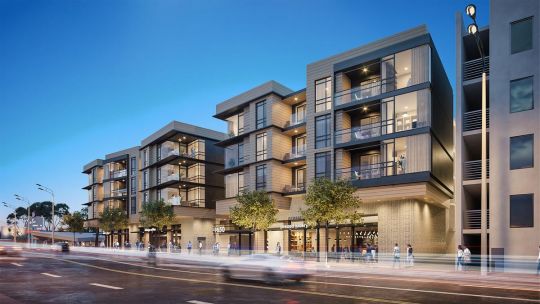
Project Specifications
1. FLOORING
Vitrified tiles of 3 x 3
Terrace and dry balcony: Rustic finish anti-skid ceramic tiles.
2. ELECTRIFICATION
Switches: Modular switches
Distribution board: Double door.
3. KITCHEN
Black granite countertop platform
Stainless steel sink.
4. DOORS AND WINDOWS
Aluminum window: 3 track powder coated with net MS grill
Main floor frame and main door and locks.
5. TOILETS
E-board false ceiling
Common toilet: Wall hung commode wash basin mixer diverter
Master bedroom toilet: Wall hung commode wash hand basin diverter with a basin mixer.

6. PLASTER
Internal: Gypsum plaster
Paint: Oil bound distemper.
7. PLUMBING
Internal: PPRC pipes and fittings
External: ASTM and UPVC.
8. BRICKWORK
Fly ash brick.
9. SPORTS & FITNESS
Aerobics Centre
Cricket Pitch
Jogging Track.
10. ENTERTAINMENT & SOCIALIZING
Barbecue
Multipurpose Hall
Party Lawn.
11. SERVICES
Shopping Centre
CONVENIENCE & SECURITY
CCTV Camera Security.
Master Plan

Location :-
Sector110, Gurgaon is one of the lately developed areas of Gurgaon. Being an integral part of the national capital region, Gurgaon has always been on the radar of the builders as well as homebuyers. Being a planned city, Gurgaon has quickly emerged as a realty hotspot. Now the city is running short of residential and commercial space. It is adjoining Sector-109 and Choma which has major hospitals and schools in proximity. Indiabulls Enigma Sector 110 Gurgaon

Developer :-
Find Indiabulls Developer- Properties, New Commercial and residential property ready to move. Get full details & Price of latest projects by Indiabulls Developers on Dwarka Expressway Gurgaon. Indiabulls Enigma Dwarka Expressway
Get More Information:-
Shalabh Mishra
Mobile: 9212306116
Gmail: [email protected]
Skype: shalabh.mishra
Kindly.visit:-https://goo.gl/kKTC2i
#Indiabulls Enigma Project In Gurgaon#4BHK Apartment Sector 110 Gurgaon#5BHK Apartment Sector 110 Gurgaon#Indiabulls Enigma Dwarka Expressway#Indiabulls Enigma Sector 110 Gurgaon
0 notes
Text
Buy Apartment Indiabulls Enigma On Dwarka Expressway
Gurgaon, the residential center of India, is among one of the most developed cities in the nation. Over the last years, Gurgaon has seen some of the significant growths in its property market. The prices of the business in addition to houses are on a high on a routine basis. In addition, Indiabulls Enigma in Gurgaon the close closeness of the city to the airport terminal has additionally provided a side to Gurgaon over the other significant cities in India.
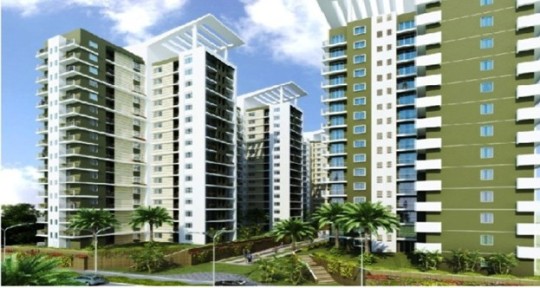
Project Specifications
1. FLOORING
Vitrified tiles of 3 x 3
Terrace and dry balcony: Rustic finish anti-skid ceramic tiles
2. ELECTRIFICATION
Switches: Modular switches
Distribution board: Double door
3. KITCHEN
Black granite countertop platform
Stainless steel sink
4. DOORS AND WINDOWS
Aluminum window: 3 track powder coated with net MS grill
Main floor frame and main door and locks
5. TOILETS
E-board false ceiling
Common toilet: Wall hung commode wash basin mixer diverter
Master bedroom toilet: Wall hung commode wash hand basin diverter with a basin mixer.
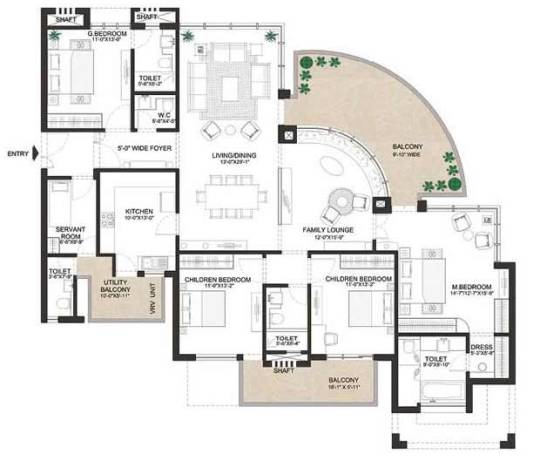
6. PLASTER
Internal: Gypsum plaster
Paint: Oil bound distemper
7. PLUMBING
Internal: PPRC pipes and fittings
External: ASTM and UPVC
8. BRICKWORK
Fly ash brick
9. SPORTS & FITNESS
Aerobics Centre
Cricket Pitch
Jogging Track
10. ENTERTAINMENT & SOCIALIZING
Barbecue
Multipurpose Hall
Party Lawn
11. SERVICES
Shopping Centre
CONVENIENCE & SECURITY
CCTV Camera Security
Master Plan
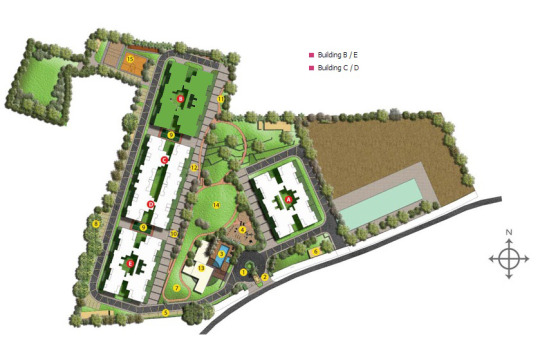
Location
Sector110, Gurgaon is one of the lately developed areas of Gurgaon. Being an integral part of the national capital region, Gurgaon has always been on the radar of the builders as well as homebuyers. Being a planned city, Gurgaon has quickly emerged as a realty hotspot. Now the city is running short of residential and commercial space. It is adjoining Sector-109 and Choma which has major hospitals and schools in proximity.
Developer
Indiabulls is one of the leading business houses in India. Having been rewarded?Business Superbrand? by The Brand Council, Superbrands India in 2008, the Indiabulls group has its business concerns in different sectors. Founded in May 2000 the group?s foray in real estate sector has been nothing short of spectacular. Indiabulls Real Estate Limited is the group?s real estate arm which is one of the largest realty companies in India, responsible for the development of projects spread across mega townships, hotels and resorts, premium residential spaces and expansive economic zones. Buy Flats Indiabulls Enigma Sector 110, Indiabulls builders developers demonstrate highest quality and standards in various aspects of construction including design, landscaping, and engineering. It has more than 90 of its real estate portfolio in major Mumbai, Delhi NCR, and Chennai. The real estate constructions company also holds the distinction of being listed on the Mumbai.
Get More Information:-
Shalabh Mishra
Mobile: 9212306116
Gmail: [email protected]
Skype: shalabh.mishra
Kindly.visit:- https://goo.gl/kKTC2i
#Flats For Sale On Dwarka Expressway#Indiabulls Enigma in Gurgaon#Buy Apartment Indiabulls Enigma On Dwarka Expressway#Ready to Move Flats Indiabulls Enigma Sector 110
0 notes
Text
Wall Hung Toilet In Mumbai:
The best Wall Hung Toilet in Mumbai has a variety of designs and size to suit your needs
0 notes
Text
Wall Hung Toilet In Mumbai
The best Wall Hung Toilet in Mumbai has a variety of designs and size to suit your needs
0 notes
Text
Wall Hung Toilet In Mumbai
The best Wall Hung Toilet in Mumbai has a variety of designs and size to suit your needs
0 notes
Text

Wall - Hung Toilets
Salus India’s toilets are designed to save space and give your bathroom a minimalist look. They are easy to install and maintain, and are made with high-quality materials that ensure durability.
Address: Service Industry, Plot No.36, Sector No.1, Shiravne Village, Nerul, Navi Mumbai – 400706 (India).
Phone no: 932 009 9099
Website: https://salusindia.com/wall-hung-toilets/
#bathroom fittings#Imported Bathroom Fittings in Mumbai#Bathroom Fittings in India#Bathroom Accessories in Mumbai
0 notes
Text
Kitchen Taps in Mumbai
Salus Bathrooms India is a leading manufacturer of world class sanitary ware and bathroom fittings get more info to visit This website :- http://www.salusindia.com/
#Wash Basins in mumbai#Wall Hung Toilet in Mumbai#Shower Bath Fixtures in Mumbai#Bathroom Fittings in Mumbai#Best Urinals in Mumbai#designer wash basin in mumbai
0 notes
Link
The high quality best wall-hung toilets products at Salus offers guaranteed products with maximum durability and with unique innovations of the bathroom fittings you can feel and savor the difference. For more please visit us at https://imgur.com/a/rdIKvBl
#best multifunction showers in mumbai#Pressure Pump For Bathroom in Mumbai#Rain Shower Price in India
0 notes
Text
Indiabulls Enigma in Gurgaon
Indiabulls Enigma in Sector 110 Gurgaon
A ravishing flat, apartment with spectacular interiors is a dream of a large number of Indians. Presently most of the people prefer to live in spacious and ease flat, apartments where they can have fun with all the ultimate and modern day facilities. In India, Gurgaon has been a fascinating vacation spot with many corporate houses, international and national companies putting together their offices in Delhi NCR. The high disposable income group working in these ongoing corporations has increased the demand for high-end flat, Flats For Sale On Dwarka Expressway apartments in Delhi NCR.

Project Specifications
1. FLOORING
Vitrified tiles of 3 x 3
Terrace and dry balcony: Rustic finish anti-skid ceramic tiles
2. ELECTRIFICATION
Switches: Modular switches
Distribution board: Double door
3. KITCHEN
Black granite countertop platform
Stainless steel sink
4. DOORS AND WINDOWS
Aluminum window: 3 track powder coated with net MS grill
Main floor frame and main door and locks
5. TOILETS
E-board the false ceiling
Common toilet: Wall hung commode wash basin mixer diverter
Master bedroom toilet: Wall hung commode wash hand basin diverter with a basin mixer.

6. PLASTER
Internal: Gypsum plaster
Paint: Oil bound distemper
7. PLUMBING
Internal: PPRC pipes and fittings
External: ASTM and UPVC
8. BRICKWORK
Fly ash brick
9. SPORTS & FITNESS
Aerobics Centre
Cricket Pitch
Jogging Track
10. ENTERTAINMENT & SOCIALIZING
Barbecue
Multipurpose Hall
Party Lawn
11. SERVICES
Shopping Centre
CONVENIENCE & SECURITY
CCTV Camera Security
Master Plan

About The Developer
Indiabulls is one of the leading business houses in India. Having been rewarded?Business Superbrand? by The Brand Council, Superbrands India in 2008, the Indiabulls group has its business concerns in different sectors. Founded in May 2000 the group?s foray in real estate sector has been nothing short of spectacular. Indiabulls Real Estate Limited is the group?s real estate arm which is one of the largest realty companies in India, responsible for the development of projects spread across mega townships, hotels and resorts, premium residential spaces and expansive economic zones.Buy Apartment Indiabulls Enigma On Dwarka Expressway demonstrate highest quality and standards in various aspects of construction including design, landscaping, and engineering. It has more than 90 of its real estate portfolio in major Mumbai, Delhi NCR, and Chennai. The real estate constructions company also holds the distinction of being listed on the Mumbai.
Get More Information:-
Shalabh Mishra
Mobile: 9212306116
Gmail: [email protected]
Skype: shalabh.mishra
Kindly.visit:-https://goo.gl/kKTC2i
#Indiabulls Enigma in Gurgaon#Flats For Sale In Sector 110#Flats For Sale On Dwarka Expressway#Buy Apartment Indiabulls Enigma On Dwarka Expressway
0 notes
Text
Indiabulls Builders Indiabulls Enigma
Gurgaon, the residential center of India, is among one of the most developed cities in the nation. Over the last years, Gurgaon has seen some of the significant growths in its property market. The prices of the business in addition to houses are on a high on a routine basis.Indiabulls Enigma in Gurgaon the close closeness of the city to the airport terminal has additionally provided a side to Gurgaon over the other significant cities in India.
Introduction Of Indiabulls Builders Indiabulls Enigma
Get The Apartments At Dwarka Expressway New Projects Gurgaon Indiabulls Enigma Gurgaon Has Been Launched By The Indiabulls This Project Gives You All Amenities.Buy Residential Property In Indiabulls Enigma In Gurgaon Ready To Move Flat /Apartment On Dwarka Expressway Gurgaon Within Your Budget.

Project Specifications
1. FLOORING
Vitrified tiles of 3 x 3
Terrace and dry balcony: Rustic finish anti-skid ceramic tiles
2. ELECTRIFICATION
Switches: Modular switches
Distribution board: Double door
3. KITCHEN
Black granite countertop platform
Stainless steel sink
4. DOORS AND WINDOWS
Aluminum window: 3 track powder coated with net MS grill
Main floor frame and main door and locks
5. TOILETS
E-board false ceiling
Common toilet: Wall hung commode wash basin mixer diverter
Master bedroom toilet: Wall hung commode wash hand basin diverter with a basin mixer
Floor Plan

6. PLASTER
Internal: Gypsum plaster
Paint: Oil bound distemper
7. PLUMBING
Internal: PPRC pipes and fittings
External: ASTM and UPVC
8. BRICKWORK
Fly ash brick
9. SPORTS & FITNESS
Aerobics Centre
Cricket Pitch
Jogging Track
10. ENTERTAINMENT & SOCIALIZING
Barbecue
Multipurpose Hall
Party Lawn
11. SERVICES
Shopping Centre
CONVENIENCE & SECURITY
CCTV Camera Security
Master Plan

Sector-110 Gurgaon Highlights
Sector110, Gurgaon is one of the lately developed areas of Gurgaon. Being an integral part of the national capital region, Gurgaon has always been on the radar of the builders as well as homebuyers. Being a planned city, Flats For Sale In Sector 110 Gurgaon has quickly emerged as a realty hotspot. Now the city is running short of residential and commercial space. It is adjoining Sector-109 and Choma which has major hospitals and schools in proximity.

About Developer
Indiabulls is one of the leading business houses in India. Having been rewarded?Business Superbrand? by The Brand Council, Superbrands India in 2008, the Indiabulls group has its business concerns in different sectors. Founded in May 2000 the group?s foray in real estate sector has been nothing short of spectacular. Indiabulls Real Estate Limited is the group?s real estate arm which is one of the largest realty companies in India, responsible for the development of projects spread across mega townships, Flats For Sale On Dwarka Expressway hotels and resorts, premium residential spaces, and expansive economic zones. Indiabulls builders developers demonstrate highest quality and standards in various aspects of construction including design, landscaping, and engineering. It has more than 90 of its real estate portfolio in major Mumbai, Delhi NCR, and Chennai. The real estate constructions company also holds the distinction of being listed on the Mumbai.
Get More Information:-
Shalabh Mishra
Mobile: 9212306116
Gmail: [email protected]
Skype: shalabh.mishra
Kindly.visit:-https://goo.gl/kKTC2i
#Indiabulls Enigma in Gurgaon#Flats For Sale In Sector 110#Flats For Sale On Dwarka Expressway#Buy Apartment Indiabulls Enigma On Dwarka Expressway
0 notes
Text
BATHROOM ACCESSORIES MUMBAI
Wash Basins · Wall - Hung Toilets · One - Piece Toilets · Urinals · Shower Panels · Rain Showers · A.B.S Head & Hand Shower · Ceramic Vanity Tray · Multi-Function Shower Heads · Health Faucet · Multi-Function Diverters · Faucet · Angle Valve · EPDM Connect Pipe · PEX Connection Pipe get more info: - https://www.salusindia.com/product?product=7
#SHOWER DRAINERS IN MUMBAI#BEST RAIN SHOWERS IN MUMBAI#BEST URINALS IN MUMBAI#DESIGNER WASH BASINS IN MUMBAI#BEST HEALTH FAUCET IN MUMBAI
0 notes